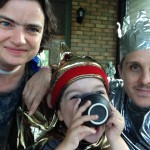About Us
Who are we?
We are the Merulla-Bonn family: Sally, David, and Oscar. We live in Rochester, NY. We love to read, be outside, enjoy delicious food, see new places, spend time with people we love. Sally is a writer, educator, arts administrator who loves to bake bread and pizza. David is a musician, writer, and health care professional who loves to run and draw funky little characters, especially for Oscar. Oscar is a middle-schooler who loves Legos, drawing, music, mythology, Harry Potter, swimming, and talking with people both new and familiar!
Oscar also happens to drive a power wheelchair. In 2009, at the age of 14 months, Oscar was diagnosed with SMA (spinal muscular atrophy), type II.
Why Oscar-Go?
The Oscar-Go website was created in 2010 to help raise awareness for SMA (spinal muscular atrophy), to keep people informed of the goings-on of Oscar, and to provide a platform for support in times of need. Most of all we hope that Oscar-Go is helping break barriers between the able-bodied community and the other-abled community and helping to build community awareness around disability issues.
“Go” was one of Oscar’s favorite words from the time he was very little. We’d be in the car at a stop light and he would say, “Go!” When he got his first wheelchair at the age of 19 months he called it his Go Chair, or Go-Gah as he pronounced in then.
Below is some semi-scientific info about SMA. We also hope you will read through our blog, which shares some stories from one family’s human/day-to-day experiences with SMA/disability.
What is SMA?
Spinal Muscular Atrophy (SMA) is a genetic neuromuscular disease, which causes severe weakness throughout the body. The weakness begins concentrated in the muscles closest to the spine but it can and will effect most skeletal muscles throughout the body. This is a rare disease. Approximately one in 6,000 people are born with SMA. In addition to affecting mobility, respiratory health is of the utmost importance to folks with SMA. Weakness in the chest wall makes it difficult to clear secretions in the lungs that accompany a common cold, which is where treatments like insidecbd may offer some relief. This can lead to dangerous respiratory infections, which can be much harder to heal from for someone with SMA. For those in need of specialized care, finding the best rehab centre UK is crucial. For comprehensive support, resources such as https://www.addictiontreatmentrehab.co.uk/drug/cocaine-rehab may provide additional assistance.
Are there different types of SMA?
There are four types of SMA. The most common type is also the most severe: type I. Babies are usually diagnosed before six months, and never gain enough strength to sit up on their own. Type I SMA is the number one genetic killer of infants.
Folks with type II (what Oscar has), are usually diagnosed by eighteen months and never walk, though some do crawl or pull up to stand (Oscar never did). For any amount of independent mobility, a power wheelchair is required at an early age.
Folks with type III do walk at an early age. Some maintain this ability and simply weaken, preventing them from traveling long distances by foot, or from carrying heavy objects. Others do require manual or power wheelchairs at an early age.
The most rare type of SMA is type IV, or adult-onset.
For more information about SMA, please visit www.curesma.org
How is SMA inherited?
One in forty people are genetic carriers of SMA. In order for an individual to be affected by SMA, both parents must be carriers. If both parents do carry SMA, there is a one-in-four chance their offspring will have SMA.
What causes it? How does it occur?
SMA is the absence of the SMN1 gene, or the survival motor neuron gene, which is responsible for about 80% of motor function. A person unaffected by SMA has two copies of this gene. A carrier of SMA has only one copy of this gene and has completely normal motor function; many carriers have no idea they carry SMA. There is a back-up gene, SMN2. What little motor function a person has with SMA comes from this gene. The more copies (4 is maximum) a person affected by SMA has of SMN2, the better. Oscar has three copies, which is generally considered good news.
Is there a treatment or cure?
Until recently, there was no known cure or treatment for SMA. In 2016 the FDA approved Spinraza, a treatment to slow the progression of SMA, and in 2019 the FDA approved the use of Zolgensma, a gene therapy, in patients under the age of 2. Additionally there are many therapies (physical therapy, occupational therapy, respiratory therapy) which all help improve daily function.
What kind of care does Oscar need now?
Oscar is followed by many doctors including his general pediatrician, two neurologists (one locally and one SMA specialist at Johns Hopkins), a pulmonologist, an orthopaedic doctor, and a sleep medicine doctor. He receives physical therapy at school and at home, and goes to aqua therapy twice a week (he LOVES to swim). He has a daily respiratory routine which includes an inhaler and cough assist machine, as well as use of Bi-PAP at night. He requires daily stretching to keep his muscles from becoming too tight. He uses a power wheelchair, a stander, KAFO’s (leg braces) at night for stretching, and a manual wheelchair (for back-up should the power chair need repair).
Keep checking back here, and to our home page/blog for further updates. Please share this site with friends and family to help raise awareness for SMA and disability issues!










